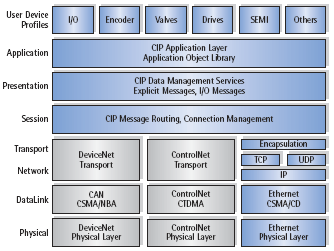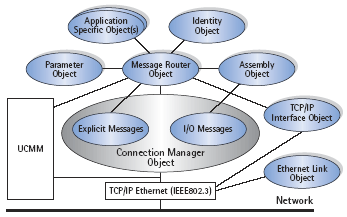EtherNet/IP is one of three open network standards (DeviceNetTM, ControlNetTM and EtherNet/IPTM), which all use a common application layer, the "Common Industrial Protocol" (CIPTM). This common application layer and open software and hardware interfaces allow a universal connection of automation components from the fieldbus level over the control level to the enterprise level.
The Family of CIP Networks is specified and published by ODVA (Open DeviceNet Vendor Association - http://www.odva.org ![]() ) and CI (ControlNet International - http://www.controlnet.org
) and CI (ControlNet International - http://www.controlnet.org ![]() ).
).
The Common Industrial Protocol presents communication and application in the object model. Predefined objects facilitate the data exchange of different devices and manufacturers. By creating various device profiles, additional user benefits were achieved.
CIP is a connection based protocol. It defines the exchange of I/O data using I/O Messaging (or Implicit Messaging) as well as the exchange of general data for configuration, diagnostic and management via Explicit Messaging. CIP thus provides 4 essential functions to the user:
- Common object model for application
- Common communication model for data exchange in the network
- Common configuration methods
- Common device profiles
EtherNet/IP is the implementation of CIP over TCP/IP and Ethernet (IEEE 802.3).
The EtherNet/IP specification defines Layer 4, Layer 3 (Encapsulation Protocol and usage of TCP/IP), Layer 2 (Usage of Ethernet IEEE 802.3), Layer 1 and Layer 0 (Physical Layer and Transmission Media).
Connectors, cable types and cable lengths are specified as are communication-based displays, operating elements and the corresponding labeling of the housing.
EtherNet/IP supports data rates of 10 Mbit/s and 100 Mbit/s. Normally, a star topology using suitable (managed) switches is built. The number of devices connected in an EtherNet/IP network depends only on the available IP-Address space.
In contrast to DeviceNet, as of yet, the EtherNet/IP standard does not specify a network power.
Besides factory automation with I/O-modules, valves, encoders, drives and controls (PLC), the main field of application of EtherNet/IP is the networking of both the control and the enterprise level. Within the Family of CIP Networks, EtherNet/IP covers applications where medium to large amount of data with medium cycle times (10 ms to 500 ms and above) need to be exchanged in the network.